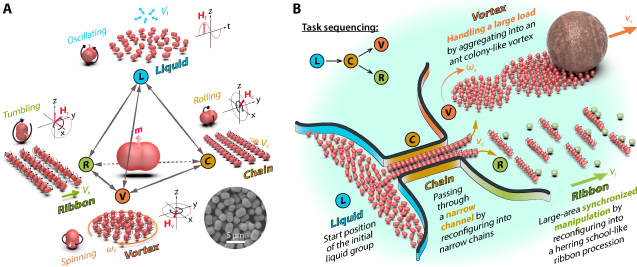Written by: Liu Peixiang
Translated by: YU Shuangshuang
Edited by: William Mosteller
Date: 3-25
HIT has developed a magnetic swimming microrobot for cancer diagnosis and treatment
Professor XIE Hui and his team of the State Key Laboratory of Robotics and Systems in the HIT School of Mechatronics Engineering have published a research paper entitled “Reconfigurable magnetic microrobot swarm: Multimode transformation, locomotion, and manipulation” in Science Robotics, a sub-journal of the journal Science. This achievement is expected to provide an effective solution for efficient delivery of the target drug and early diagnosis in vivo imaging during cancer treatment. Our university is the unit of the first author and the communication unit.
There are abundant and diverse biological self-organizing systems in nature, which show a high degree of swarm intelligence and can solve complex problems that individuals are not competent to do. Colonies of coordinated ants can build complex and elaborate nests and carry overweight prey, while herrings can easily catch highly alert copepods through array predation. Inspired by this, Professor XIE Hui and his team developed a magnetic swimming microrobot with a peanut shape, which is 3 microns in length and 2 microns in diameter (about one-fortieth the diameter of a human hair). This kind of robot enables thousands of robots to work together in teams and communicate with each other through very small forces to form a multimodal swarm, just as ant colonies communicate with tactile senses or smells. Under the regulation of rotating magnetic field, the swarm exhibits a variety of modes that respond quickly to environment or tasks, and which can be deformed into long-chain modes and efficiently traverse long and narrow simulated capillaries. In addition, the swarm can simulate natural ant colonies (vortex modes) and herring predator arrays (transverse band modes) to perform large-load controllable transport and large-area synchronous cluster cleanup operations respectively.
The robots are small enough to reach places that are difficult to treat directly, such as the end of capillaries and the retina. In the future, through in vivo motion navigation, thousands of drug-loaded swimming microrobots will be able to directly reach lesion areas and identify and attack the pathological cells, achieving efficient and side-effect-free treatment. At the same time, micro-nano swimming robots can also remain in the body, to implement in vivo monitoring of health conditions, to assist the immune system with long-term effective maintenance of health, and to provide a new means for the early diagnosis and treatment of diseases.
Founded in December 2016, Science Robotics is aimed at the dissemination of representative research results in robotics-related fields, with an average of no more than four research articles published in each issue. It is reported that this paper, published in such an international authoritative journal, marks another important breakthrough for Professor XIE Hui and his team, after their innovative research results were published in Nature Communications in late 2017.
Paper Link: http://robotics.sciencemag.org/content/robotics/4/28/eaav8006.full.pdf

Multimodal Transformation of Swimming Microrobot Swarm (Left)
Environmental Response and Cluster Operation (Right)


